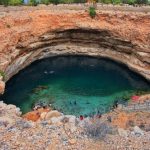 Technology
Technology  Technology
Technology  Humans
Humans 10 Everyday Human Behaviors That Are Actually Survival Instincts
 Animals
Animals 10 Animals That Humiliated and Harmed Historical Leaders
 History
History 10 Most Influential Protests in Modern History
 Creepy
Creepy 10 More Representations of Death from Myth, Legend, and Folktale
 Technology
Technology 10 Scientific Breakthroughs of 2025 That’ll Change Everything
 Our World
Our World 10 Ways Icelandic Culture Makes Other Countries Look Boring
 Misconceptions
Misconceptions 10 Common Misconceptions About the Victorian Era
 Mysteries
Mysteries 10 Strange Unexplained Mysteries of 2025
 Miscellaneous
Miscellaneous 10 of History’s Most Bell-Ringing Finishing Moves
 Technology
Technology Top 10 Everyday Tech Buzzwords That Hide a Darker Past
 Humans
Humans 10 Everyday Human Behaviors That Are Actually Survival Instincts
 Animals
Animals 10 Animals That Humiliated and Harmed Historical Leaders
Who's Behind Listverse?

Jamie Frater
Head Editor
Jamie founded Listverse due to an insatiable desire to share fascinating, obscure, and bizarre facts. He has been a guest speaker on numerous national radio and television stations and is a five time published author.
More About Us History
History 10 Most Influential Protests in Modern History
 Creepy
Creepy 10 More Representations of Death from Myth, Legend, and Folktale
 Technology
Technology 10 Scientific Breakthroughs of 2025 That’ll Change Everything
 Our World
Our World 10 Ways Icelandic Culture Makes Other Countries Look Boring
 Misconceptions
Misconceptions 10 Common Misconceptions About the Victorian Era
 Mysteries
Mysteries 10 Strange Unexplained Mysteries of 2025
 Miscellaneous
Miscellaneous 10 of History’s Most Bell-Ringing Finishing Moves
10 Amazing Architecture Secrets from Around the World
There is remarkable architectural design around the world. Whether it’s Tokyo’s sleek and modern cityscape or Paris’s towering historical landmarks, being an architecture enthusiast has never been more exciting. It’s easy to overlook the hidden gems and clever designs tucked away within various places and structures. That’s why we’ve compiled a list of 10 amazing architectural secrets worldwide you can experience on your next travel adventure.
Related: 10 Amazing Ancient Buildings Still In Use Today
10 London’s Tower Bridge Has Hidden Chambers
Anyone familiar with British culture will undoubtedly be aware of London’s Tower Bridge, one of England’s most distinguished landmarks. Standing tall at more than 200 feet (61 meters), this structure is a suspension bridge spanning the River Thames, which can allow both road and river traffic to pass through. What some people might not know, however, is that the bridge holds a secret: the Bascule Chambers.
The Bascule Chambers were originally built to help move large counterweights during bridge lifts. Mostly off-limits to the public, the chambers are made up of two massive main halls, both 99.5 feet (27 meters) in height and located inside the piers of the bridge. Construction wasn’t easy, as engineers had to meticulously excavate foundations beneath the River Thames, lowering themselves into the depths via steel cages. From time to time, the Bascule Chambers open up to the public for special events and tours.[1]
9 There Are Optical Illusions in the Parthenon
Athens, Greece, is home to the Parthenon, an architectural masterpiece built sometime between 447 and 432 BC. It was intended to replace a previously damaged temple. It is one of the most visited heritage sites in the world, seen by millions of tourists every year. The structure was made with pure white marble and used no cement or mortar. The Greek architect Phidias oversaw the construction of the Parthenon, including things like a statue of Athena, the structure’s famous white columns, and a little bit of secret mathematics that created a fascinating optical illusion.
The Parthenon is intentionally designed with geometric irregularities, such as non-equidistant columns that slope inward. These imperfect lines help give the building the impression of perfect geometry and alignment due to how the human eye perceives depth. Designers had to take human perception into account and correct for it.[2]
8 Discover A Secret Crypt underneath Washington D.C.’s Capitol
Washington D.C.’s Capitol is one of the most well-known historical landmarks in the United States. First constructed in 1793, the Capitol was established as an official building to house the U.S. Congress. Its location in Washington D.C. was a compromise between the American North and South. What some people may not know, however, is that there is a secret crypt hidden beneath the Capitol building.
The crypt, originally called the Grand Vestibule, was built for George Washington and his wife, Martha, to serve as their final resting places. However, numerous disagreements and delays within Congress kept the remains of the Washingtons from being placed in the crypt itself. The space has a European Cathedral design in its substructure, giving it an eerie, mausoleum look and atmosphere. To this day, the crypt remains empty, save for the statues of notable figures from the founding days of Colonial America.[3]
7 New York Public Libraries Have Secret Apartments
New York City boasts some of the largest and most impressive libraries in the world. It is the fourth-largest library system in the entire world. Over 11 million books comprise the New York Public Library’s incredible research collection. There’s one thing that visitors of the library may not be aware of, however: secret apartments located in the building.
There are about 13 hidden apartments left in the library, a holdover from the time when the library custodians and their families would live in them. Due to renovations over the decades, these apartments now lay empty, with most of them removed. Currently, the library plans to turn the remaining apartments into program spaces to better accommodate the library’s ever-changing needs. Many of these spaces are decrepit and decaying, standing as a reminder of a curious time in the library’s history.[4]
6 Notre Dame’s Gargoyles Also Function as Waterspouts
Notre Dame Cathedral is one of the crowning jewels of French architecture. Located in Paris, France, this Gothic cathedral is world-famous and is replete with intricate, ornate design elements. The gargoyles of the cathedral are perhaps just as famous as the church itself (many people will be familiar with Disney’s The Hunchback of Notre Dame and its gargoyle characters). These statues resemble mythical creatures, such as dragons, demons, and so on, and are carved magnificently from stone. But some people may not know that the gargoyles act as a secret water drainage system.
Rainwater was a huge problem to the cathedral during its early days, as there were no gutters or collection systems in the church. Running water would potentially ruin the building material, causing erosion and cracks. Engineers decided to create gutters within the flying buttresses of the church itself, using the gargoyles to drain water out as part of the drainage network. And best of all, the system blended in perfectly with the architecture.[5]
5 One Times Square Is Mostly Empty
Times Square in New York City is one of the most famous and visited locations on the planet. It is the very heart of Manhattan, home to one of the largest entertainment hubs in the world and the iconic Broadway theater district. Each year on New Year’s Eve, the famous New Year’s ball drops from Times Square’s One Times Square building to ring in the new year. From the outside, One Times Square looks like any other business skyscraper, but it’s actually empty inside.
One Times Square is one of the most expensive pieces of real estate in the world, but it relies almost entirely on advertising space to make millions in revenue. For 364 days of the year, the interior of the building stays empty and unused. The reason for this is that getting the building up to safety codes is currently a very difficult task, meaning it’s much easier to keep it vacant.[6]
4 St. Peter’s Square in the Vatican City Has a Secret Sundial
The Vatican City is more than just the holy home of the pope himself. The official spiritual center of Catholicism serves as the Roman Catholic Church’s administrative headquarters, along with being the home of around 800 members of the church who work directly under the pope. It is home to landmark wonders like St. Peter’s Basilica, the Vatican Museums, Sistine Chapel, and so on. Many would-be Vatican visitors may not know that the famous St. Peter’s Square in the city actually has a hidden sundial designed into it.
The paving stones in St. Peter’s Square, made from marble and granite meridian, act as clock markers. In the middle of the square rests an 82-foot (25-meter) stone obelisk, operating as the sundial itself, which can tell time quite accurately from the sun’s shadow cast. This was first created for both timekeeping and astronomy purposes back in the 18th century.[7]
3 Brighton Pavilion’s Secret Tunnels
Brighton, England, attracts many tourists with its beachfront, resorts, and historical architecture every year. The city is also home to one of the largest underground tunnel networks in England. These secret tunnels are 147 years old and web outward vast distances beneath Brighton. They were first designed in the 1870s for use as intricate sewage systems. Brighton suffers from occasional heavy rainfall, so these drainage systems are vital to avoid damage and loss.
Victorians didn’t want to deal with cesspools, which would put waste directly into their backyards, which led to one of the largest engineering projects in British history. Millions of bricks were meticulously placed and cemented with Brighton Beach sand, which is even more impressive given that this was long before power tools and hydraulics were a thing. The tunnels also served as secret passageways for royalty and servants to pass from the Royal Pavilion to Brighton Dome.[8]
2 The Chrysler Building Has a Hidden Spire
Located in Manhattan, New York City, the Chrysler Building is one of the world’s tallest skyscrapers. It was built in 1930 by architect William Van Alen and is most known for its distinctive Art Deco design. Its architecture is flush with arched entrances, eagle gargoyles, intricate ornamentation, and its trademark spire, which is adorned with triangular windows and crown-like structures. The Chrysler Building has a secret, however: a hidden spire inside of it.
During the building’s construction, architects and engineers were competing with other designers for the title of the world’s tallest building. But they didn’t want to give away their final height until the very last second. The solution was to construct the spire within the crown of the building itself, then raise it when it was time to show off the final height. And though the Chrysler building ultimately lost the height wars, remnants of that secret spire still exist within the crown to this day.[9]
1 The Capitol Records Building Sends a Secret Message in Morse Code
Built in 1956, the Capitol Records Building in Hollywood, California, is one of the city’s most famous landmarks. Its futuristic space-age design sticks out distinctly against LA’s urban backdrop. It was originally created as a headquarters for one of the most important record labels in the United States, Capitol Records. This historical building also displays a secret message in Morse code.
The idea of having the building emit Morse code messages in the sky was originally the idea of former Capitol Records president Alan Livingstone. Leila Morse, daughter of Samuel Morse, inventor of the Morse code, was given the honor of turning on the Capitol Records skylight when the building first opened. In her honor, the light has been emitting this Morse code ever since its establishment, keeping the legacy of her namesake alive in the night sky.[10]








